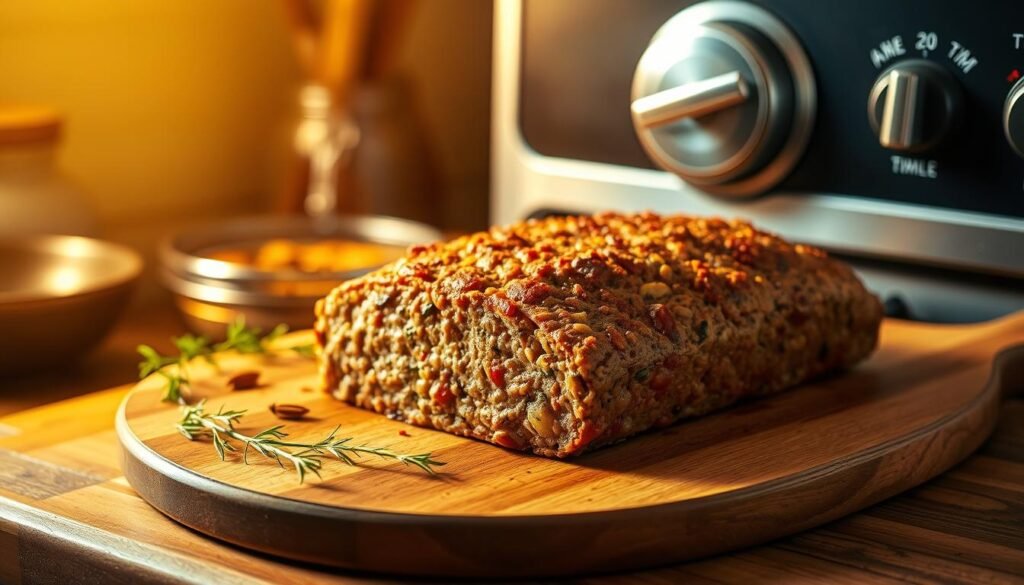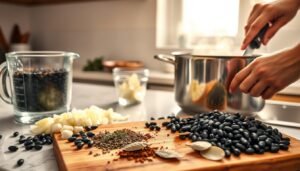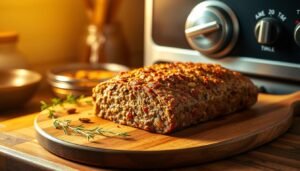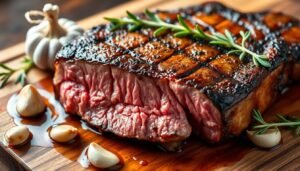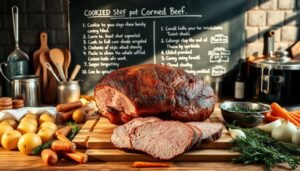Did you know nearly 50% of home cooks struggle with making the perfect meatloaf? This classic American dish is more than just a meal; it’s about taste and safety. I learned the secret to a delicious meatloaf by figuring out the right cooking time.
In this article, we’ll look at what makes meatloaf cooking time important. We’ll also share a simple recipe to make your next meal a hit with everyone. You’ll learn how to make a meatloaf that’s both tasty and moist.
Key Takeaways
- Understanding the ideal cooking time is crucial for juicy meatloaf.
- Recipes often suggest cooking temperatures between 350°F to 375°F.
- Ingredient proportions significantly affect baking time and texture.
- Oven type can lead to variations in meatloaf cooking time.
- Using a meat thermometer ensures perfect doneness every time.
- Letting meatloaf rest after baking improves flavor and moisture.
Understanding Meatloaf Basics
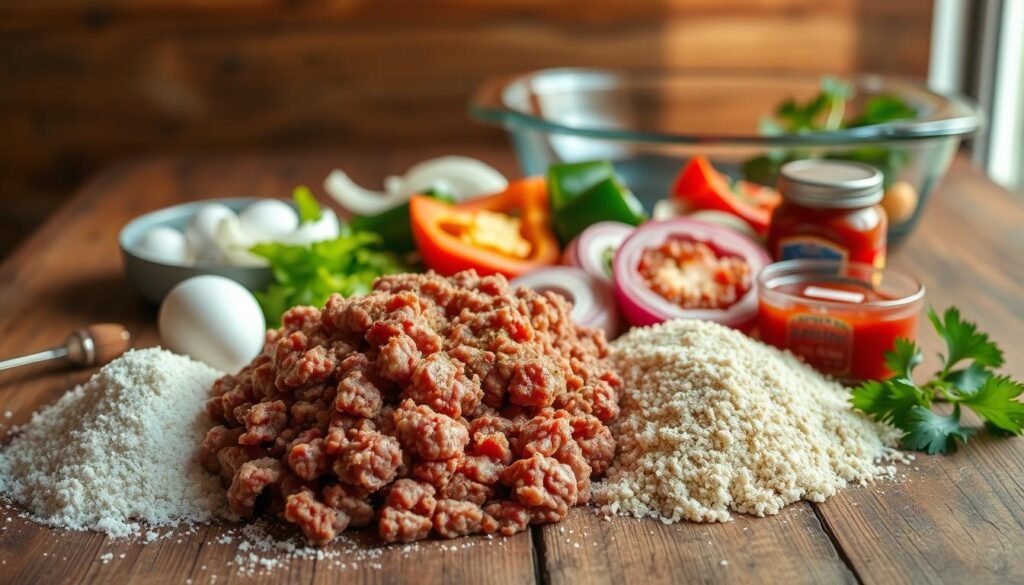
Meatloaf is a comforting dish great for family dinners or meal prep. Knowing the basic components is key. It’s important to understand the common ingredients, the right types of meat, and how to prepare it.
What Ingredients are Commonly Used?
A classic meatloaf needs a few key ingredients for flavor and texture. These include:
- Lean ground beef (around 90% lean for optimal juiciness)
- Breadcrumbs for binding
- Eggs for moisture
- Seasonings like salt, pepper, and Worcestershire sauce
- A tangy glaze made from ketchup (optional)
Types of Meat for Meatloaf
There are many types of meat for meatloaf to make your dish unique. While ground beef is traditional, you can try:
- Ground turkey for a leaner option
- Ground pork for added richness
- A combination of meats for a more complex flavor profile
Preparation Methods
Preparing meatloaf is simple. I start by mixing the ingredients in a large bowl. Then, I shape the mixture into a loaf and bake it until it’s done. This way, the meatloaf is flavorful and juicy, perfect with your favorite sides.
Recommended Cooking Times
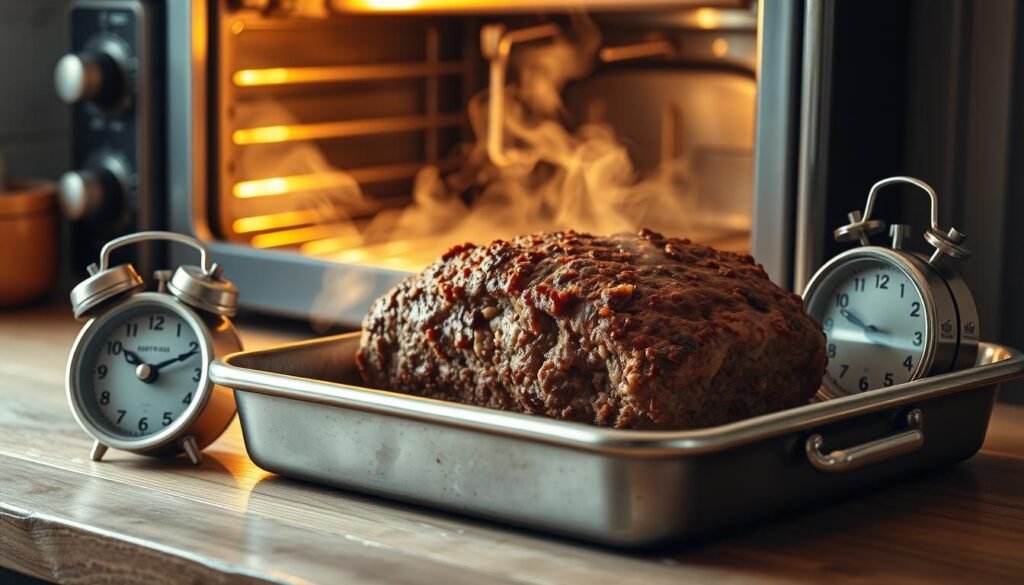
Understanding cooking times and temperatures is key for baking meatloaf. The size and thickness of the meatloaf affect how long it bakes. Having a reliable guide ensures a perfectly cooked dish.
General Baking Guidelines
The general rule is to bake at 350°F. It takes about 35 to 45 minutes for each pound. For example:
| Meatloaf Size | Estimated Cooking Time |
|---|---|
| 1 lb | 45 minutes |
| 2 lb | 1 hour to 1 hour 20 minutes |
| 3 lb | 1.5 to 2 hours |
These times can vary. Using an oven thermometer ensures accuracy.
Cooking at Different Temperatures
Cooking at different temperatures changes the baking time. For instance, baking at 375°F can shorten the time slightly. Every oven is different, so it’s important to watch the meatloaf closely. Adjusting the temperature helps get a nice crust without drying out the inside.Click here to learn about how to cook rice.
Adjusting for Size and Thickness
Adjusting for meatloaf size is crucial. Thicker loaves need more time to cook through. A thermometer ensures it’s cooked right and stays moist. For larger loaves, extend cooking time while keeping an eye on it.
Meatloaf Internal Temperature
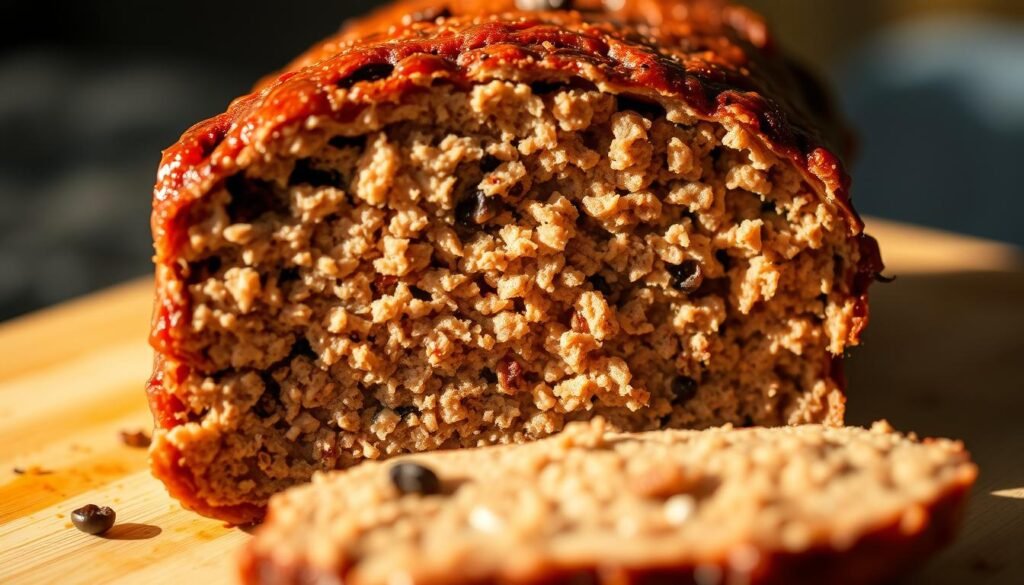
Knowing the right meatloaf internal temperature is key for safety and taste. The ideal temperature ensures the meatloaf is flavorful and safe to eat. It’s important to aim for an internal temperature of 160°F. Using a meat thermometer helps achieve this perfect temperature.
The Right Temperature for Safety
For safe meatloaf cooking, the internal temperature must be 160°F. This high temperature kills harmful bacteria, keeping you healthy. To check, insert a meat thermometer into the thickest part of the loaf. After a few seconds, you’ll get a precise reading, confirming your meatloaf is safe and cooked just right.Click Here to learn about how to cook asparagus.
How to Check Doneness
Checking if your meatloaf is done is easy with the right tools. A digital instant-read thermometer gives the most accurate readings. Remember, don’t touch the pan or the bottom of the meatloaf. When the thermometer shows 160°F, your meal is ready to enjoy!
Factors Influencing Cooking Time
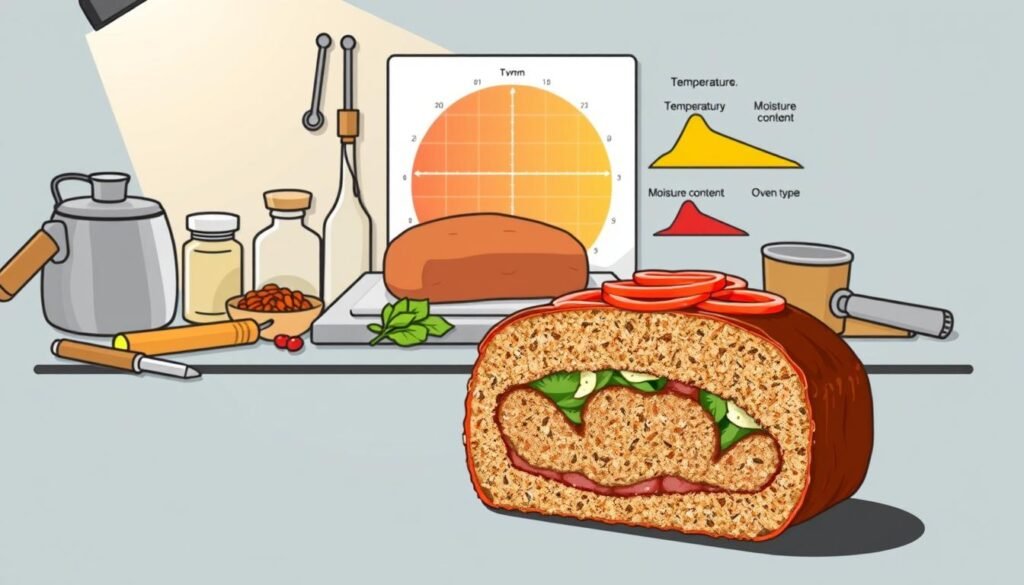
Knowing what affects cooking time is key to baking a great meatloaf. Many cooks miss how their ovens, altitude, and meatloaf mix impact cooking. These factors are crucial for success.
Oven Variability
Ovens can vary a lot in temperature and heat spread. Some might be hotter or cooler than they say. I use an oven thermometer to get my cooking times right.
Understanding these differences can make a big difference in your baking. It helps you get consistent results every time.
Altitude Considerations
Cooking at high altitudes brings its own set of challenges. The air pressure is lower, causing more moisture to evaporate. This means you need to cook your meatloaf longer to keep it moist.
Adjusting for altitude and cooking time is essential. It prevents your meatloaf from drying out and ensures it’s fully cooked.
Meatloaf Mix Variations
The ingredients in your meatloaf can change cooking times. Adding veggie fillers or using leaner meats can affect how long it takes to bake. I pay close attention to these variations to get the right texture and flavor.Here to learn about how to cook broccoli.
Using a Meat Thermometer
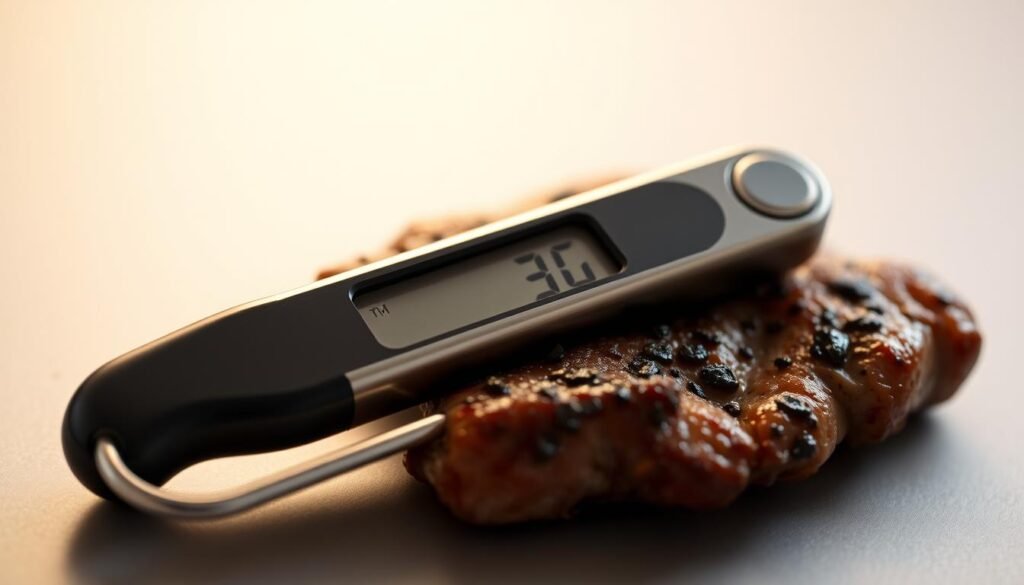
Using a meat thermometer is key when cooking meatloaf. It ensures the meatloaf is moist and flavorful. It also makes sure the meatloaf is safe to eat.
Importance of Accurate Readings
A meat thermometer gives me peace of mind while cooking. The USDA says meatloaf should be at least 160°F inside. I put the thermometer in the center of the meatloaf, away from the pan.
This way, I know the meatloaf is tender and safe. No more guessing if it’s done.
Best Practices for Thermometer Use
Using a meat thermometer the right way makes cooking meatloaf better. I check the temperature near the end of cooking. This ensures the meatloaf is perfect.
An oven-safe thermometer is great for this. It lets me check the temperature without opening the oven. This keeps the meatloaf cooking evenly and makes cooking stress-free. For more tips, I check out this helpful link.
Cooking Meatloaf in Different Ovens
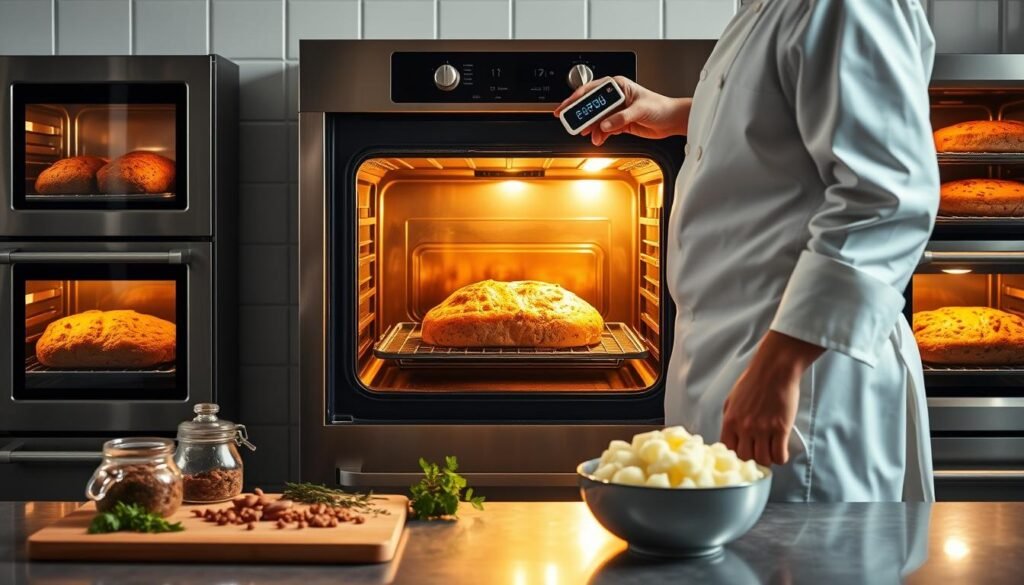
Choosing the right oven is key to a great meatloaf. Each oven has its own benefits and needs a special way to cook. This ensures the meatloaf turns out just right.
Conventional Ovens vs. Convection Ovens
Conventional ovens need close watching to avoid overcooking. But, convection ovens cook more evenly and faster. They make the crust nice and brown.
A 2-lb meatloaf cooks in 60 to 75 minutes at 350°F in a conventional oven. But, a convection oven does it in less time.Here to learn about how to cook beets.
Slow Cooker Meatloaf
Slow cookers make meatloaf moist and flavorful. Cooking it for 4 to 6 hours on low heat is perfect. It’s great for busy days when you want a ready meal.
Remember to let the meatloaf rest before slicing. This makes it juicy and full of flavor. For more cooking tips, check this resource.
| Oven Type | Cooking Time (2-lb Meatloaf) | Temperature |
|---|---|---|
| Conventional Oven | 60-75 minutes | 350°F |
| Convection Oven | 45-60 minutes | 350°F |
| Slow Cooker | 4-6 hours | Low Heat |
Resting Time After Baking
Every great meatloaf needs a break after baking, known as the meatloaf rest time. This pause lets the juices settle and spread out, making the meatloaf more flavorful and moist. Understanding the importance of resting not only boosts the taste but also makes the meal more enjoyable.
Why Resting is Important
The resting meatloaf is key for the best texture and juiciness. If I slice into a freshly baked meatloaf without resting, the juices spill out, leaving it dry. That’s why I stress the need for at least a short rest.
How Long to Let It Rest
I usually let my meatloaf rest for 10-15 minutes after baking. This time is essential for the flavors to mix well and the moisture to spread evenly. Place the meatloaf on a cutting board for easy slicing, so none of the juices escape.
If you’re curious about the best techniques, check out this meatloaf recipe that highlights the rest time. The benefits will make this extra step worth it!
| Resting Time | Benefits |
|---|---|
| 10 minutes | Juices begin to redistribute, retaining moisture. |
| 15 minutes | Enhanced flavor infusion and improved texture. |
Sides That Pair Well with Meatloaf
Choosing the right sides for meatloaf can make a meal special. Think about creamy mashed potatoes, crisp green beans, and rich macaroni and cheese. These sides balance the savory meatloaf, making dinner satisfying.
Classic Sides to Consider
Popular classic meatloaf sides include:
- Creamy mashed potatoes
- Garlic green beans
- Macaroni and cheese
- Wedge salad with buttermilk ranch dressing
- Skillet dinner rolls with garlic-herb butter
These sides go well with meatloaf, making them great for family dinners.
Creative Pairing Ideas
For unique meatloaf pairings, try sautéed veggies, roasted garlic potatoes, or a fresh Caesar salad. You could also add corn soufflé or lemon roasted asparagus for freshness. A vibrant side like candied carrots or Brussels sprouts can bring new flavors to your meal.
For more ideas, check out The Pioneer Woman’s site. They have pairing suggestions for a well-rounded, delightful meal.
Tips for Perfect Meatloaf Every Time
Making the perfect meatloaf means avoiding common mistakes and adding flavor. One big mistake is overmixing the ingredients. This makes the meatloaf dense and tough instead of juicy and tender. I mix just until everything is combined, letting the ingredients blend without getting too tight.
To improve the flavor, add ingredients like Worcestershire sauce, fresh herbs, or grated cheese. These can make your meatloaf unforgettable. Also, cook at the right temperature, around 350°F. Use a meat thermometer to check the internal temperature, aiming for 160°F to ensure it’s done.
For expert tips, follow a detailed recipe. Spend With Pennies has great guidelines for a tasty and satisfying meatloaf. By avoiding common mistakes and adding these enhancements, my meatloaf is a hit with my family every time!


